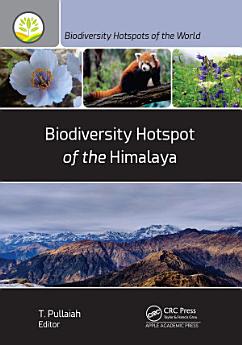Biodiversity Hotspot of the Himalaya
About this ebook
The concise volumes in this series focus on the most interesting and important properties of these hotspots, covering physiography and climatology; vegetation and forest types; amphibian and reptile biodiversity; genetic diversity of crops, plants, fishes, butterflies, insects, birds, mammals, angiosperms, and gymnosperms; and much more. And of course, the unique threats and conservation efforts for the areas are addressed as well.
The Himalayan Mountains are the highest mountain range in the world and include Mount Everest as well as eight other highest peaks of the world. While it is difficult to document the biodiversity of this inhospitable terrain, we do know that out of the 9,000 different species of plants recorded in the area, 3,500 plants are endemic to the Eastern Himalaya region. Anthropogenic activities including deforestation, fragmentation of habitats, pollution, high population, climate change, and poaching of wildlife pose serious threats to the biodiversity of the region. The highlands have exceptionally rich biodiversity, high endemism, and over 160 globally threatened species, including the densest population of Bengal tigers and the three largest herbivores on the continent: the Asian elephant, greater one-horned rhinoceros, and wild water buffalo. The region boasts the world’s richest counts of alpine flora within its temperate broad-leaved forests, with a total of 10,000 species of plants.
This volume, Biodiversity Hotspot of the Himalayas, as well as the other volumes in this series, will be essential resources for researchers and practitioners in the fields of conservation biology, ecology, and evolution as the series concisely records the existing biodiversity of these hotspots of the world.
About the author
T. Pullaiah, PhD, is a former Professor in the Department of Botany at Sri Krishnadevaraya University in Andhra Pradesh, India, where he has taught for more than 35 years. He has held several positions at the university, including Dean, Faculty of Biosciences; Head of the Department of Botany; Head of the Department of Biotechnology; and member of the Academic Senate. He was President of the Indian Botanical Society (2014), President of the Indian Association for Angiosperm Taxonomy (2013), and Fellow of Andhra Pradesh Akademi of Sciences. Under his guidance, over 50 students obtained their doctoral degrees. He has authored over 70 books, edited over 40 books, and published over 340 research papers, including reviews and book chapters. His books include Redsanders: Silviculture and Conservation (Springer), Genetically Modified Crops (Springer), Sandalwood: Silviculture, Conservation and Applications (Springer), Advances in Cell and Molecular Diagnostics (Elsevier), Camptothecin and Camptothecin Producing Plants (Elsevier), Paclitaxel (Elsevier), Monograph on Brachystelma and Ceropegia in India (CRC Press), Ethnobotany of India (5 volumes, Apple Academic Press), Global Biodiversity (4 volumes, Apple Academic Press), and Invasive Alien Species (4 volumes, Wiley Blackwell). He was also a member of the Species Survival Commission of the International Union for Conservation of Nature (IUCN). Professor Pullaiah received his PhD from Andhra University, India, attended Moscow State University, Russia, and worked as Post-Doctoral Fellow during 1976-1978.








